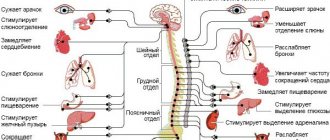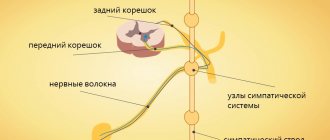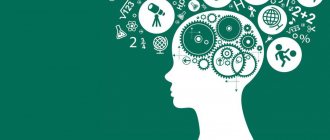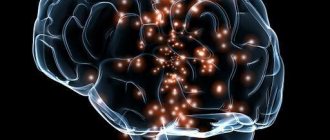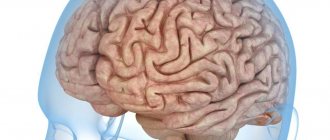In the modern education system, the school psychological service, today called “Practical Psychology of Education”, considers the development of the individuality of each child, the scientific substantiation and operationalization of ways and means of an individual approach to any child in the context of his individual version of age development in order to implement resources of his creative and moral potential in educational institutions of various types and levels [5], since “the formation of a creative personality involves taking into account both her own individual capabilities and the requirements of the activity itself” [1; 2].
From these positions, this article highlights questions about how the natural prerequisites for their psychophysiological and personal development in educational activities and life activities are revealed, manifested and developed in schoolchildren.
General characteristics of the properties of the nervous system and human temperament
As you know, there are no two people on Earth with the same skin patterns on their fingers, and there are no two completely identical leaves on a tree. In the same way, in nature there are no absolutely identical human personalities - the personality of each person is unique and inimitable.
However, a person is not born with an already formed personality. He becomes one gradually. But even before a person becomes an individual, he has individual characteristics that are manifested in behavior, activity, life, and various types of activity: emotional, intellectual, volitional, motor, communicative, etc. These mental characteristics are very conservative and stable. Changing much more slowly than the personality properties known to us, they form in each person a unique psychological soil, on which subsequently, depending on its characteristics, personality properties inherent only to this person “grow.” This means that the child’s psyche is not like a smooth board on which any patterns can be written, and that in the process of raising and teaching a child one must rely on the properties he has from birth. These properties are different for everyone.
Such stable and inherent individual properties of a person from birth are physiological properties such as the nervous system and their psychological manifestations - properties of temperament. What makes them unique? Imagine two rivers: one calm, flat, the other fast, mountainous. The flow of the first is barely noticeable, it smoothly carries its waters, it does not have bright splashes, stormy waterfalls, or dazzling splashes. The course of the second is the complete opposite. The river rushes quickly, the water in it rumbles, seethes, bubbles and, hitting the stones, turns into shreds of foam. The flow characteristics of these rivers depend on a number of natural conditions.
Something similar can be observed in the dynamics (features of the flow) of the mental activity of different people. For some people, mental activity proceeds evenly. Such people are always outwardly calm, balanced and even slow. They rarely laugh, their gaze is always stern and cold, their movements are stingy and expedient. Finding themselves in difficult circumstances or in a “ridiculous” situation, these people remain outwardly unperturbed. Their facial expressions and gestures are not varied and expressive, their speech is calm, their gait is firm. For other people, mental activity occurs spasmodically. Such people, on the contrary, are very active, restless, noisy, and always lively. Their speech is impetuous and passionate, their movements are chaotic, their facial expressions are rich and varied. Often, even in ordinary conversation, their words are accompanied by gestures - a person waves his arms, stamps his feet. They are always fussy and impatient. In other words, the properties of the nervous system and temperament are those that are natural, i.e. innate properties that determine the dynamic side of human mental activity [4].
A scientific explanation of their nature was given by Academician I.P. Pavlov in the doctrine of the basic properties of the nervous system. He identified the following three main properties: 1) the strength of the process of excitation and inhibition, depending on the performance of nerve cells; 2) balance of the nervous system, i.e. the degree of correspondence between the excitation force and the braking force (or their balance); 3) mobility of nervous processes, i.e. the rate of change from excitation to inhibition, and vice versa. I.P. Pavlov found that temperament does not depend on any one of these properties, but on their combination. He called this combination of properties of the nervous system, which determines both the individual characteristics of conditioned reflex activity and temperament, the type of nervous system. I.P. Pavlov distinguished four main types of nervous system:
- strong, unbalanced (with a predominance of the excitation process),
- strong, balanced, agile,
- strong, balanced, inert,
- weak.
Identified I.P. Pavlov, the main combinations of properties, or types, of the nervous system, on which temperament depends, are common in humans and animals. Therefore they are called general types. These general types of the nervous system underlie the four traditional types of temperament: choleric, sanguine, phlegmatic and melancholic, which are quite clearly expressed already at school age.
Sanguine.
This is a subject with a strong, balanced, mobile type of nervous system. A sanguine person is distinguished by increased reactivity, which manifests itself in the liveliness with which his emotional nature responds to everything. He is characterized by great activity - he is able to show significant energy, efficiency and perseverance. The activity and reactivity of a sanguine person are balanced - he can restrain feelings and worries. The reaction rate is quite high, so he loves fast movements. A sanguine person is characterized by high plasticity and extroversion, as a result of which he is sociable, easily gets used to new people and conditions, easily moves from one type of activity to another, but is not sufficiently diligent and focused, especially in conditions of monotonous work. During the learning process, he quickly grasps the main points, but makes mistakes. Does not like painstaking and lengthy work to master complex knowledge or develop skills and abilities. He is quite efficient, self-confident, the results of his activities are stable and, as a rule, in important situations (exams, competitions, etc.) are higher than in the situation of a regular lesson or training.
Choleric.
Has a strong, unbalanced (with a predominance of excitation) type of nervous system. He, like the sanguine person, is characterized by high reactivity, activity, and a fast pace of reactions. But his reactivity prevails over activity, and therefore in a difficult situation he easily becomes hot-tempered, abrupt, and quickly loses his temper. Like a sanguine person, he loves fast movements, willingly and enthusiastically begins to engage in his chosen activity, but quickly cools down. Does not like long and monotonous work. His results are not stable enough, because he is prone to excessive excitement before starting responsible work, which often does not allow him to fully realize his capabilities.
Phlegmatic person.
This is a person with a strong, balanced, inert type of nervous system. Unlike sanguine and choleric people, he has little reactivity, so it is difficult to anger him. Minor emotional excitability allows him to remain calm before serious, responsible work. High activity prevails over low reactivity, which determines patience, endurance and self-control. A phlegmatic person's movements and speech are slow, reactions are delayed. He is characterized by rigidity and introversion, which determines the stability of habits and skills, and low sociability.
Melancholic.
A subject with a weak type of nervous system. The most characteristic of it is high sensitivity, manifested in painful sensitivity and vulnerability. Low reactivity and reduced activity contribute to the fact that he is easily “lost”, quickly gets tired, and lacks self-confidence. The melancholic person is responsible, but is not efficient enough and is not resistant to external stimuli. High anxiety often gives rise to self-doubt and low self-esteem. In a situation of responsible work, a melancholic person, as a rule, shows less good results than in the course of everyday activities.
Functions of the central nervous system
We have clarified which organs belong to the central nervous system; now we need to figure out what functions it performs. The main processes include:
- Control of muscle movement.
- Ensuring the functioning of the senses and smell.
- Regulation of the function of the endocrine glands.
The central nervous system has many cells and nodes in its structure.
The important sections are the cells of the white and gray matter. Gray matter contains components such as: neuronal processes (dendrites), axons and astrocytes. As for the white matter, it contains only axons.
The role of the properties of the nervous system and temperament in human activity
If we evaluate the above characteristics, we can note that each of them has both positive and negative properties. Thus, a sanguine person is emotional and has good performance, but his motives are unstable, and his attention is also unstable. A melancholic person is characterized by less efficiency and greater anxiety, but he is a sensitive person, as a rule, careful and prudent. Consequently, there are no “bad” temperaments, no “good” temperaments - each temperament is good in some conditions and bad in others. It also does not determine the social value of a person - a person’s inclinations, worldview and beliefs, and the content of his interests do not depend on temperament.
Each activity places certain demands on the human psyche and its dynamic characteristics. These requirements cannot be changed arbitrarily, since they depend on objective reasons - on the content of the activity.
Temperament and the type of nervous system, determining the dynamics of activity, can influence its productivity. Their role is different in different types of activities. In educational activities and in “mass” professions (turner, mechanic, manager, doctor, teacher, engineer), some properties necessary for successful activity and weakly expressed in a given person can be compensated for by other properties and work methods determined by them . For example, it has been established that teachers with a strong mobile type of nervous system (sanguine by temperament) are characterized by an organizational and communicative style of activity in the classroom. Good organization of the lesson ensures its high efficiency. They predominate in disciplining with words, directly when violations of discipline occur or after them (they easily tolerate the effects of strong irritants), they use punishment to a lesser extent when organizing students, they often come into contact with students and directly with the class in order to convey educational information and discipline students . The constructive component of their activity is less pronounced than the organizational and communicative component. Their lesson plan, as a rule, is condensed and sketchy. During the lesson, it is significantly detailed and clarified. This is explained by the fact that they almost completely lack preliminary orientation - it occurs during the execution process. Such teachers are very active, they can easily adapt during the lesson depending on the state of the students, the degree of their assimilation of educational material, they are prone to impromptu, improvisation, they are always cheerful, optimistic, cheerful, they achieve success due to good organization and readiness. In these features of the teacher’s activity, there are positive manifestations inherent in a strong and mobile type of nervous system: confidence, determination, activity, independence, efficiency. Negative manifestations - haste, lack of restraint, impulsiveness, arrogance - are compensated by appropriate methods of action, pedagogical techniques, and insufficient advance preparation for the lesson by the fact that these teachers can “on the fly” mobilize their knowledge, skills, skills, quickly think through the current situations of the lesson and creatively solve them.
Each property of temperament requires individual methods of work or influence on a person. So, melancholic people get tired quickly. Therefore, they need more frequent rest breaks than others. The emotional sphere of the individual also depends on temperament, and hence the effectiveness of disciplinary actions or the motivating force of the motive, and the influence on the activity of various mental states caused by a tense situation, emotional factors, and pedagogical influences. It has been proven that an increase or decrease in the functional level of activity is determined by the magnitude of the stimulus that causes neuropsychic stress.
The magnitude of the stimulus at which the functional level increases is usually called optimal, and at which it decreases it is called pessimal. The optimal and pessimal values of the current stimulus depend on the type of nervous system and temperament. For example, a remark from a teacher made to a sanguine student in a harsh manner only disciplines him, but unsettles a melancholic student for a long time. Thus, the influence of various factors that determine the level of neuropsychic stress (for example, assessment of activity, expectation of control of activity, acceleration of the pace of work, the influence of emotional stimuli, work difficulties, disciplinary actions, etc.) depends on temperament. Such regulation of the educational activities of schoolchildren by differentiating the magnitude of the acting stimuli depending on the type of nervous system and the person’s temperament is recommended by psychologists and applied (though rather spontaneously) by master teachers. Adaptation of temperament to activity consists in individualizing the requirements, conditions and methods of work placed on a person (individual approach).
There is the most universal way to adapt temperament to the requirements of activity - the formation of its individual style. The same tasks and requirements of educational activities can be achieved with equal success through various techniques and methods. An individual style of activity is understood as an individual system of techniques and methods of action that is characteristic of a given person and is appropriate for achieving a successful result.
One of the conditions for the formation of an individual style is taking into account the properties of the type of nervous system and temperament. A person chooses such techniques and methods of performing actions that best suit his temperament. The techniques and methods of action that are most appropriate to temperament depend on the often completely involuntary and unaccountable forms of reaction and movement characteristics determined by temperament. For example, a melancholic student, when doing written work, due to self-doubt and anxiety, spends a lot of time on drafting, checking and correcting it, and comparatively less on rewriting completely. A sanguine student, on the contrary, sometimes writes a draft very briefly or even does not use it at all and checks and corrects his work very little.
The learning activity style (ALS) at the Perm Psychological School is traditionally the subject of close study. The dependence of individual style on the properties of the nervous system and temperament was discovered and proven [3; 6]. For example, younger schoolchildren with a strong, balanced, mobile type of nervous system have a fast pace of activity, are active in lessons, and, in addition to basic tasks, manage to complete additional ones. They are characterized by thoughtful answers, a preference for completing difficult tasks, greater concentration during lessons, and attention to the teacher’s explanation of the material. As a rule, they do not take breaks when doing homework, check their work for a long time and carefully, prefer to complete tasks on their own, not copy from their friends and do not use hints.
Teenagers with a similar type of nervous system are not prone to lengthy and thorough checks of completed work, prefer to study alone, and are less likely to be distracted during lessons. During the lesson, they manage to complete additional tasks in addition to the main ones, take their time, carefully think through their answers, they rarely make mistakes due to inattention, they are attentive to the teacher’s explanation of the lesson and prepare their workplace for the lesson in a timely manner. Typically, they tend to check tasks only during their execution, without exercising final control [7].
One of the most important conditions for the emergence of an individual style is a conscious, creative attitude to the work performed. An individual style arises only if schoolchildren themselves look for the best techniques and methods to help them achieve better results. Therefore, individual style is most clearly manifested in more successful students and does not appear spontaneously. It is formed in the process of training and education.
In each class there are children with different properties of the nervous system and temperament. Those techniques and methods of educational activity that are acceptable for one student may not correspond to the individual psychological characteristics of another. In this regard, one of the tasks of teachers and parents is to help the child find the most suitable learning style for him. To do this you need the following.
1. Before starting work on developing a style of educational activity in a particular child, a teacher (parent), in collaboration with a school psychologist, should, using observations, various tests and questionnaires, examine his individual psychological characteristics and analyze which techniques and methods of educational activity are for a given student, the most acceptable, favorable (Appendix 1 and Appendix 2 present specific methods for diagnosing the properties of the nervous system and the style of educational activity in schoolchildren - note PG). An analysis of existing curricula gives reason to say that modern conditions for organizing educational activities in general are more consistent with the individual characteristics of children with a strong and active type of nervous system. In this regard, special attention of teachers and parents should be directed to the formation of an adequate style of educational activity in children with a weak and inert type of nervous system. So, for example, when working with students with a “weak” nervous system, it should be remembered that it is extremely undesirable to put such children in a situation of an unexpected question and an immediate answer to it, since for a more successful answer and (no less important) for greater internal comfort and emotional satisfaction they need more time to think about; as a rule, such children feel more confident giving answers in writing; during the lesson they should be distracted from work as little as possible; For an important task (exam, test, etc.), students with similar natural characteristics should be psychologically prepared, instilled in them confidence in their abilities, taught to cope with their fears, anxiety, etc. Students with an inert type of nervous system should not be required to quickly engage in work, be highly active in the lesson, they need more time to prepare and check the assignment, etc.
2. The manifestation of a student’s individual psychological characteristics in educational activities can play both a positive and negative role. Teachers and parents, when helping a child in the formation of a rational SUD, should not impose on him certain techniques and methods of work. The work should be structured in such a way that he (the child) realizes that in some situations his individual characteristics contribute to higher success in his activity, and in others - in some way they hinder it. The student’s ability to organize work taking into account his own individual characteristics will help him not only achieve better results in his studies, but also avoid undesirable conditions (overload, emotional overstrain, stress, etc.).
3. In each specific case, depending on the diagnosis, a process of individualization in the education and upbringing of the student is outlined in order to optimize them. In any case, it is advisable to consult a school psychologist.
Features of the brain
The anatomy of the central nervous system consists of brain structures. One of them is the human brain. It is reliably protected and is located in the skull; in addition, it is surrounded by three protective shells, namely:
- The outer layer is the hardest shell.
- Web protection.
- Soft shell.
Between the last two membranes there is a space that is filled with serous fluid. The soft shell consists of blood vessels and provides nutrition to the brain cells.
The peculiarity of the arachnoid membrane is that it does not fit tightly to the grooves of the brain, due to which it forms a space filled with cerebrospinal fluid.
In the center of the brain there are four cavities that are responsible for stabilizing intracranial pressure and for the exchange of cerebrospinal fluid.
Bibliography
- Vyatkin B.A., Shchukin M.R. Psychology of human styles: textbook. allowance / Ross. acad. education; Perm. state humanit.-ped. univ. - Perm: Book World, 2013. - 128 p.
- Vyatkin B.A., Shchukin M.R. Man - style - society: polysystem interaction in the educational space: monograph. - Perm, 2007. - 108 p.
- Merlin V.S. Essay on an integral study of individuality. - M.: Pedagogy, 1986. - 256 p.
- Merlin V.S., Vyatkin B.A. Temperament // General psychology: textbook. for pedagogical students Institute / ed. prof. A.V. Petrovsky. — 2nd edition, add. and processed - M.: Education, 1976. - P. 405–421.
- Psychological service in modern education: workbook / ed. I.V. Dubrovina. - St. Petersburg: Peter, 2009. - 400 p.
- Psychology of integral individuality: Perm school / comp. B.A. Vyatkin, L.Ya. Dorfman, M.R. Shchukin. - M.: Smysl, 2011. - 636 p.
- Sambikina O.S. The relationship between the development of the style of educational activity and the integral individuality of junior schoolchildren and adolescents // Polysystemic study of human individuality / ed. B.A. Vyatkina. - M.: PER SE, 2005. - pp. 165–172.
Source: Vyatkin B.A., Sambikina O.S. Types of the nervous system and temperament as natural prerequisites for the formation of a student’s style of educational activity // Bulletin of the Perm State Humanitarian-Pedagogical University. Series No. 1. Psychological and pedagogical sciences. 2014. Vol. 1. pp. 81–100.
September 22, 2021 is the anniversary of Oksana Semyonovna Sambikina , head of the Department of Theoretical and Applied Psychology of the Faculty of Psychology, head of the master’s program “Family Psychology and Family Counseling” at Perm State Humanitarian Pedagogical University. “Psychological Newspaper” congratulates Oksana Semyonovna and wishes her health, inspiration and strength for the implementation of all creative and scientific plans!
How is it structured?
The brain
is
the center of the nervous system
: approximately the same as the processor in a computer.
The wires and ports of this “supercomputer” are the spinal cord and nerve fibers. They permeate all the tissues of the body like a large network. Nerves transmit electrochemical signals from different parts of the nervous system, as well as other tissues and organs. In addition to the nerve network called the peripheral nervous system, there is also the autonomic nervous system
. It regulates the functioning of internal organs, which is not consciously controlled: digestion, heartbeat, breathing, and the release of hormones.
